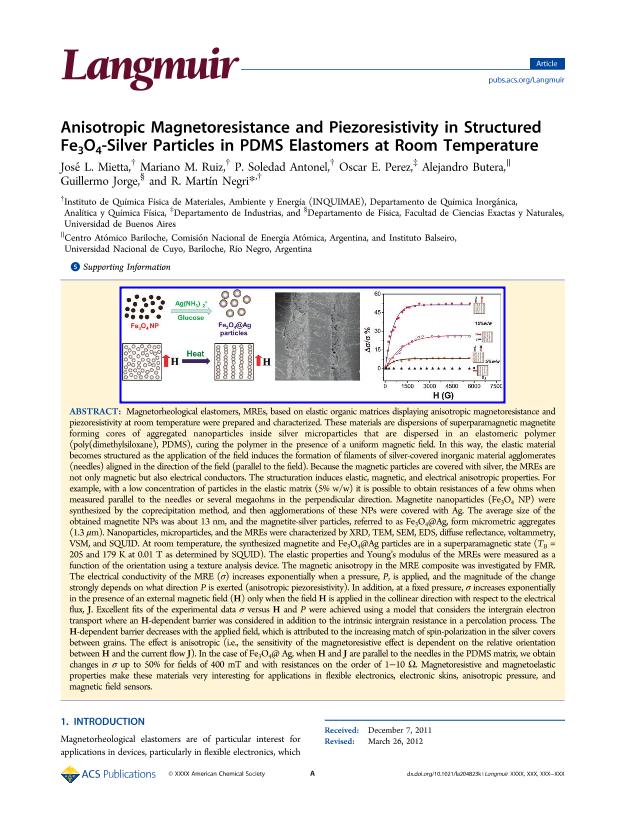Artículo
Anisotropic magnetoresistance and piezoresistivity in structured Fe 3O 4-silver particles in PDMS elastomers at room temperature
Mietta, José L.; Ruiz, Mariano Manuel ; Antonel, Paula Soledad
; Antonel, Paula Soledad ; Perez, Oscar Edgardo
; Perez, Oscar Edgardo ; Butera, Alejandro Ricardo
; Butera, Alejandro Ricardo ; Jorge, Guillermo; Negri, Ricardo Martin
; Jorge, Guillermo; Negri, Ricardo Martin
 ; Antonel, Paula Soledad
; Antonel, Paula Soledad ; Perez, Oscar Edgardo
; Perez, Oscar Edgardo ; Butera, Alejandro Ricardo
; Butera, Alejandro Ricardo ; Jorge, Guillermo; Negri, Ricardo Martin
; Jorge, Guillermo; Negri, Ricardo Martin
Fecha de publicación:
05/2012
Editorial:
American Chemical Society
Revista:
Langmuir
ISSN:
0743-7463
Idioma:
Inglés
Tipo de recurso:
Artículo publicado
Clasificación temática:
Resumen
Magnetorheological elastomers, MREs, based on elastic organic matrices displaying anisotropic magnetoresistance and piezoresistivity at room temperature were prepared and characterized. These materials are dispersions of superparamagnetic magnetite forming cores of aggregated nanoparticles inside silver microparticles that are dispersed in an elastomeric polymer (poly(dimethylsiloxane), PDMS), curing the polymer in the presence of a uniform magnetic field. In this way, the elastic material becomes structured as the application of the field induces the formation of filaments of silver-covered inorganic material agglomerates (needles) aligned in the direction of the field (parallel to the field). Because the magnetic particles are covered with silver, the MREs are not only magnetic but also electrical conductors. The structuration induces elastic, magnetic, and electrical anisotropic properties. For example, with a low concentration of particles in the elastic matrix (5% w/w) it is possible to obtain resistances of a few ohms when measured parallel to the needles or several megaohms in the perpendicular direction. Magnetite nanoparticles (Fe 3O 4 NP) were synthesized by the coprecipitation method, and then agglomerations of these NPs were covered with Ag. The average size of the obtained magnetite NPs was about 13 nm, and the magnetite-silver particles, referred to as Fe 3O 4@Ag, form micrometric aggregates (1.3 μm). Nanoparticles, microparticles, and the MREs were characterized by XRD, TEM, SEM, EDS, diffuse reflectance, voltammetry, VSM, and SQUID. At room temperature, the synthesized magnetite and Fe 3O 4@Ag particles are in a superparamagnetic state (T B = 205 and 179 K at 0.01 T as determined by SQUID). The elastic properties and Young's modulus of the MREs were measured as a function of the orientation using a texture analysis device. The magnetic anisotropy in the MRE composite was investigated by FMR. The electrical conductivity of the MRE (σ) increases exponentially when a pressure, P, is applied, and the magnitude of the change strongly depends on what direction P is exerted (anisotropic piezoresistivity). In addition, at a fixed pressure, σ increases exponentially in the presence of an external magnetic field (H) only when the field H is applied in the collinear direction with respect to the electrical flux, J. Excellent fits of the experimental data σ versus H and P were achieved using a model that considers the intergrain electron transport where an H-dependent barrier was considered in addition to the intrinsic intergrain resistance in a percolation process. The H-dependent barrier decreases with the applied field, which is attributed to the increasing match of spin-polarization in the silver covers between grains. The effect is anisotropic (i.e., the sensitivity of the magnetoresistive effect is dependent on the relative orientation between H and the current flow J). In the case of Fe 3O 4@ Ag, when H and J are parallel to the needles in the PDMS matrix, we obtain changes in σ up to 50% for fields of 400 mT and with resistances on the order of 1-10 Ω. Magnetoresistive and magnetoelastic properties make these materials very interesting for applications in flexible electronics, electronic skins, anisotropic pressure, and magnetic field sensors.
Archivos asociados
Licencia
Identificadores
Colecciones
Articulos(INQUIMAE)
Articulos de INST.D/QUIM FIS D/L MATERIALES MEDIOAMB Y ENERGIA
Articulos de INST.D/QUIM FIS D/L MATERIALES MEDIOAMB Y ENERGIA
Citación
Mietta, José L.; Ruiz, Mariano Manuel; Antonel, Paula Soledad; Perez, Oscar Edgardo; Butera, Alejandro Ricardo; et al.; Anisotropic magnetoresistance and piezoresistivity in structured Fe 3O 4-silver particles in PDMS elastomers at room temperature; American Chemical Society; Langmuir; 28; 17; 5-2012; 6985-6996
Compartir
Altmétricas



